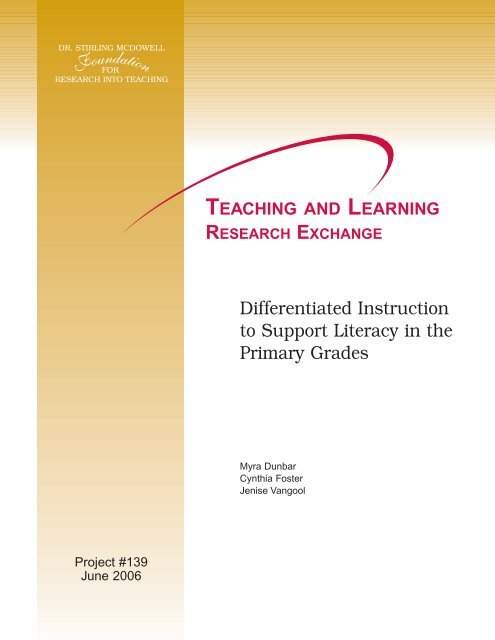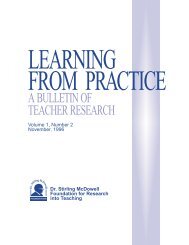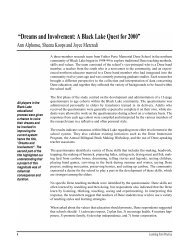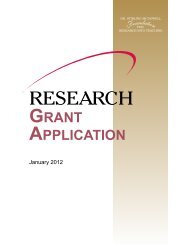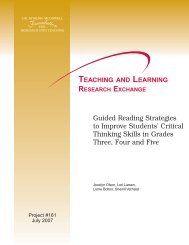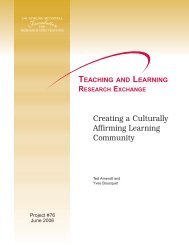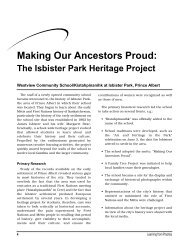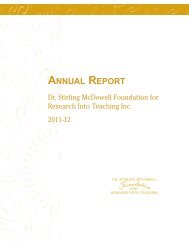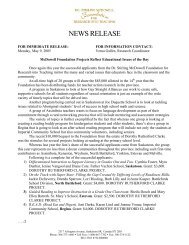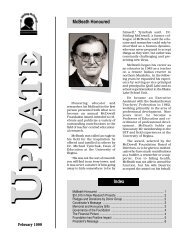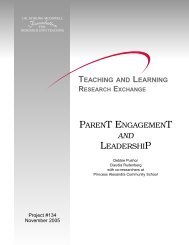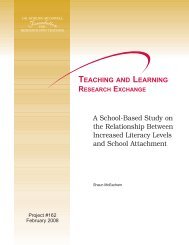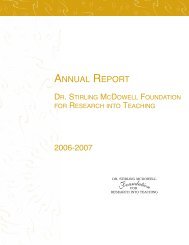Differentiated Instruction to Support Literacy in the Primary Grades
Differentiated Instruction to Support Literacy in the Primary Grades
Differentiated Instruction to Support Literacy in the Primary Grades
You also want an ePaper? Increase the reach of your titles
YUMPU automatically turns print PDFs into web optimized ePapers that Google loves.
TEACHING AND LEARNING<br />
RESEARCH EXCHANGE<br />
<strong>Differentiated</strong> <strong>Instruction</strong><br />
<strong>to</strong> <strong>Support</strong> <strong>Literacy</strong> <strong>in</strong> <strong>the</strong><br />
<strong>Primary</strong> <strong>Grades</strong><br />
Myra Dunbar<br />
Cynthia Foster<br />
Jenise Vangool<br />
Project #139<br />
June 2006
This research was partially funded through a grant from <strong>the</strong> McDowell Foundation. However, <strong>the</strong> po<strong>in</strong>ts of view<br />
and op<strong>in</strong>ions expressed <strong>in</strong> project documents are those of <strong>the</strong> authors and do not necessarily reflect <strong>the</strong> views<br />
of <strong>the</strong> Foundation.<br />
The purpose of <strong>the</strong> Dr. Stirl<strong>in</strong>g McDowell Foundation for Research <strong>in</strong><strong>to</strong> Teach<strong>in</strong>g is <strong>to</strong> fund research, <strong>in</strong>quiry and<br />
dissem<strong>in</strong>ation of <strong>in</strong>formation focus<strong>in</strong>g on <strong>in</strong>struction (both teach<strong>in</strong>g and learn<strong>in</strong>g) <strong>in</strong> <strong>the</strong> context of <strong>the</strong> public<br />
elementary and secondary education system. Specifically, it will:<br />
1) contribute <strong>to</strong> knowledge about teach<strong>in</strong>g and learn<strong>in</strong>g;<br />
2) encourage educational <strong>in</strong>quiry through a wide range of methodologies;<br />
3) support <strong>the</strong> <strong>in</strong>volvement of practis<strong>in</strong>g teachers <strong>in</strong> active research projects;<br />
4) encourage organizations as well as <strong>in</strong>dividuals <strong>to</strong> determ<strong>in</strong>e and act <strong>in</strong> areas of research and <strong>in</strong>quiry; and<br />
5) encourage experimentation with <strong>in</strong>novative ideas and methodologies related <strong>to</strong> teach<strong>in</strong>g and learn<strong>in</strong>g.<br />
The Foundation is an <strong>in</strong>dependent charitable organization formed by <strong>the</strong> Saskatchewan Teachers’ Federation<br />
<strong>in</strong> 1991. It is governed by a Board of Direc<strong>to</strong>rs with <strong>the</strong> assistance of an Advisory Committee of representatives<br />
from <strong>the</strong> educational and bus<strong>in</strong>ess communities. The selection and evaluation of projects funded by <strong>the</strong><br />
Foundation is carried out by a teacher-led Project Review Committee. Inquiries concern<strong>in</strong>g research supported<br />
by <strong>the</strong> McDowell Foundation may be directed <strong>to</strong> <strong>the</strong> follow<strong>in</strong>g address:<br />
Research Coord<strong>in</strong>a<strong>to</strong>r<br />
Dr. Stirl<strong>in</strong>g McDowell Foundation<br />
2317 Arl<strong>in</strong>g<strong>to</strong>n Avenue<br />
Saska<strong>to</strong>on SK S7J 2H8<br />
Telephone: 1-800-667-7762 or (306) 373-1660<br />
This project was funded through a generous gift from<br />
<strong>the</strong> Estate of <strong>the</strong> late Dorothy Ru<strong>the</strong>rford Clarke.<br />
© 2006 by <strong>the</strong> Dr. Stirl<strong>in</strong>g McDowell Foundation for Research <strong>in</strong><strong>to</strong> Teach<strong>in</strong>g Inc. Permission is given <strong>to</strong> use this<br />
work for educational purposes, except that authorization from <strong>the</strong> orig<strong>in</strong>al source must be obta<strong>in</strong>ed for <strong>the</strong> use<br />
of any material that appears <strong>in</strong> <strong>the</strong> work with credit <strong>to</strong> ano<strong>the</strong>r source.
Acknowledgements<br />
We would like <strong>to</strong> extend our thanks <strong>to</strong> <strong>the</strong> follow<strong>in</strong>g people who supported our<br />
research:<br />
• First, <strong>the</strong> Dr. Stirl<strong>in</strong>g McDowell Foundation, with recognition <strong>to</strong> <strong>the</strong> Estate of<br />
Dorothy Ru<strong>the</strong>rford Clarke for its f<strong>in</strong>ancial support of this project.<br />
• Second, <strong>the</strong> excellent team at Fa<strong>the</strong>r Vachon School who graciously gave of <strong>the</strong>ir<br />
time and talents <strong>in</strong> our centres. We would like <strong>to</strong> acknowledge <strong>the</strong>m by name:<br />
Kathy Ketterer, Erma Laliberte, Jan<strong>in</strong>e Ackerman, Tara Scheck, Wayne Craig,<br />
Marion Up<strong>to</strong>n, Karren Walker, Charlene Zipchen, Jeff Kostyniuk and Brandi<br />
Elder.<br />
• Third, <strong>the</strong> school adm<strong>in</strong>istra<strong>to</strong>rs Diane Côté and Bur<strong>to</strong>n Harper that lent<br />
support <strong>in</strong> encouragement, organization of space and technology, and assistance<br />
with students.<br />
Truly it was a team effort.<br />
RESEARCH REPORT: <strong>Differentiated</strong> <strong>Instruction</strong> <strong>to</strong> <strong>Support</strong> <strong>Literacy</strong> <strong>in</strong> <strong>the</strong> <strong>Primary</strong> <strong>Grades</strong><br />
i
Dedication<br />
In lov<strong>in</strong>g memory of Erma Jean who was always open <strong>to</strong> new ideas,<br />
will<strong>in</strong>g <strong>to</strong> be part of new <strong>in</strong>itiatives, cared deeply for her students, and<br />
had a laugh that was awesome. We will miss you.<br />
ii<br />
RESEARCH REPORT: <strong>Differentiated</strong> <strong>Instruction</strong> <strong>to</strong> <strong>Support</strong> <strong>Literacy</strong> <strong>in</strong> <strong>the</strong> <strong>Primary</strong> <strong>Grades</strong>
Table of Contents<br />
In The Beg<strong>in</strong>n<strong>in</strong>g .....................................................................................................1<br />
Literature Review .....................................................................................................2<br />
The First Step..........................................................................................................3<br />
The Who and The How.............................................................................................4<br />
What <strong>the</strong> Information Collected Told Us...................................................................12<br />
Setbacks and Limitations .......................................................................................14<br />
The Next Step ........................................................................................................15<br />
Bibliography and References...................................................................................16<br />
Appendices ............................................................................................................17<br />
1. Assessment Tools List<br />
2. Outl<strong>in</strong>e for Centre School<br />
3. Graphs Show<strong>in</strong>g Improvement <strong>in</strong> Student <strong>Literacy</strong><br />
4. Samples of Student Writ<strong>in</strong>g<br />
RESEARCH REPORT: <strong>Differentiated</strong> <strong>Instruction</strong> <strong>to</strong> <strong>Support</strong> <strong>Literacy</strong> <strong>in</strong> <strong>the</strong> <strong>Primary</strong> <strong>Grades</strong><br />
iii
iv<br />
RESEARCH REPORT: <strong>Differentiated</strong> <strong>Instruction</strong> <strong>to</strong> <strong>Support</strong> <strong>Literacy</strong> <strong>in</strong> <strong>the</strong> <strong>Primary</strong> <strong>Grades</strong>
In The Beg<strong>in</strong>n<strong>in</strong>g<br />
The big questions <strong>in</strong> our m<strong>in</strong>ds were: why are many of <strong>the</strong> primary students not<br />
read<strong>in</strong>g well and what can we do <strong>to</strong> help <strong>the</strong>m<br />
We are Myra, Jenise and Cynthia, <strong>the</strong> Learn<strong>in</strong>g Assistance Teachers at Fa<strong>the</strong>r Vachon<br />
School <strong>in</strong> Saska<strong>to</strong>on, Saskatchewan. Our school has approximately 300 students<br />
from k<strong>in</strong>dergarten <strong>to</strong> grade eight with a diverse mix of cultures and socio-economic<br />
groups. Students with special needs are embraced and we have an early <strong>in</strong>tervention<br />
program for children with behavior problems. There is also a pre-school that is<br />
structured <strong>to</strong> support children <strong>in</strong> read<strong>in</strong>ess for school. Our school has a very<br />
car<strong>in</strong>g environment for all, students and staff. The adm<strong>in</strong>istration supports learn<strong>in</strong>g<br />
for students and encourages staff <strong>to</strong> reach beyond <strong>the</strong> norm and give more <strong>to</strong> our<br />
students, <strong>the</strong>refore becom<strong>in</strong>g better teachers. From this sett<strong>in</strong>g an application for a<br />
McDowell grant was submitted <strong>to</strong> study how <strong>to</strong> better teach <strong>the</strong> grade ones and twos<br />
read<strong>in</strong>g and writ<strong>in</strong>g.<br />
Our research question orig<strong>in</strong>ated from dialogue amongst ourselves about why <strong>the</strong><br />
grade ones did not have some of <strong>the</strong> basic skills required <strong>to</strong> meet <strong>the</strong> curriculum<br />
objectives. Our role <strong>in</strong> <strong>the</strong> school is <strong>to</strong> support classroom teachers <strong>in</strong> <strong>the</strong>ir <strong>in</strong>struction<br />
of students. We wondered how we could reach <strong>the</strong> students who struggled with<br />
basics, those who were “at grade” and those who were perform<strong>in</strong>g above expectations.<br />
Of course, all teachers encounter this dilemma, but we wanted <strong>to</strong> try ability<br />
group<strong>in</strong>g across grades, collaborat<strong>in</strong>g with all <strong>the</strong> staff work<strong>in</strong>g <strong>in</strong> <strong>the</strong> grade one and<br />
two classrooms. The team of people that we <strong>in</strong>volved were all very passionate,<br />
dedicated and open <strong>to</strong> new ideas.<br />
Myra, Jenise, and Cynthia led <strong>the</strong> team and each had a unique <strong>in</strong>sight and<br />
background <strong>to</strong> contribute <strong>to</strong> <strong>the</strong> work<strong>in</strong>gs of it all.<br />
• Myra had been at <strong>the</strong> school six years and worked closely with <strong>the</strong> grade one<br />
teacher. Toge<strong>the</strong>r <strong>the</strong>y had done work with small groups and guided read<strong>in</strong>g. She<br />
was concerned about <strong>the</strong> wide variance <strong>in</strong> that classroom and <strong>the</strong> struggle <strong>to</strong><br />
reach <strong>the</strong> bot<strong>to</strong>m and <strong>to</strong>p end of students without sacrific<strong>in</strong>g <strong>the</strong> learn<strong>in</strong>g of o<strong>the</strong>rs.<br />
• Jenise had been at <strong>the</strong> school ten years and noticed <strong>the</strong> grow<strong>in</strong>g demands on<br />
families and <strong>the</strong> chang<strong>in</strong>g demographics of <strong>the</strong> community that had brought<br />
students <strong>to</strong> school with greater needs. The needs of <strong>the</strong> children were not only<br />
academic, but social as well. She was <strong>in</strong>volved <strong>in</strong> <strong>the</strong> implementation of guided<br />
read<strong>in</strong>g and saw <strong>the</strong> use of <strong>the</strong> four blocks of literacy (Fountas and P<strong>in</strong>ell,<br />
1996) as a powerful learn<strong>in</strong>g model.<br />
• Cynthia had been at <strong>the</strong> school two years and immediately noticed <strong>the</strong> warmth<br />
of <strong>the</strong> staff. She felt it could be a safe place <strong>to</strong> explore and experiment with a new<br />
method of <strong>in</strong>struction <strong>to</strong> enhance learn<strong>in</strong>g.<br />
These three women worked exceptionally well <strong>to</strong>ge<strong>the</strong>r <strong>to</strong> see <strong>the</strong> process from<br />
<strong>in</strong>ception <strong>to</strong> completion. Each one gave of her talents and collaborated with <strong>the</strong> team<br />
<strong>in</strong> a sometimes whirlw<strong>in</strong>d of activity.<br />
RESEARCH REPORT: <strong>Differentiated</strong> <strong>Instruction</strong> <strong>to</strong> <strong>Support</strong> <strong>Literacy</strong> <strong>in</strong> <strong>the</strong> <strong>Primary</strong> <strong>Grades</strong><br />
1
Literature Review<br />
Our project was based on understand<strong>in</strong>g best practice. We were <strong>in</strong>novative <strong>in</strong> <strong>the</strong> way<br />
<strong>in</strong> which we organized <strong>the</strong> project, collaborated as a team, and carried out our<br />
research <strong>in</strong><strong>to</strong> teach<strong>in</strong>g and learn<strong>in</strong>g. We <strong>to</strong>ok many ideas that have been tried <strong>in</strong> <strong>the</strong><br />
past and created a unique way <strong>to</strong> organize, collaborate, and carry out research.<br />
Thanks <strong>to</strong> <strong>the</strong> support of <strong>the</strong> McDowell Foundation we were able <strong>to</strong> use what<br />
literature has been tell<strong>in</strong>g us for years <strong>to</strong> put <strong>to</strong>ge<strong>the</strong>r a large scale read<strong>in</strong>g and writ<strong>in</strong>g<br />
ability based project.<br />
We looked at <strong>the</strong> literature regard<strong>in</strong>g good <strong>in</strong>struction for read<strong>in</strong>g and writ<strong>in</strong>g.<br />
The Saskatchewan English Language Arts Curriculum (K-5) was <strong>the</strong> first reference we<br />
used <strong>to</strong> guide us. Research about learn<strong>in</strong>g disabilities and collaboration among<br />
teachers was prom<strong>in</strong>ent <strong>in</strong> <strong>the</strong> big picture presented <strong>in</strong> this document.<br />
The curriculum pr<strong>in</strong>ciples state that <strong>the</strong> strands of speak<strong>in</strong>g, listen<strong>in</strong>g, read<strong>in</strong>g,<br />
writ<strong>in</strong>g, represent<strong>in</strong>g, and view<strong>in</strong>g “are <strong>in</strong>terrelated, <strong>in</strong>terdependent, and reciprocal.”<br />
Mean<strong>in</strong>gful and purposeful language experiences at <strong>the</strong> student’s appropriate<br />
developmental level are also pr<strong>in</strong>ciples <strong>in</strong> <strong>the</strong> curriculum that were <strong>in</strong>tegral <strong>in</strong> our<br />
project. We followed <strong>the</strong> curriculum <strong>in</strong>structional suggestions <strong>in</strong> our centres and used<br />
assessments directly from it. We pulled <strong>in</strong>formation from grades one, two and<br />
three <strong>to</strong> plan our <strong>in</strong>struction.<br />
Ano<strong>the</strong>r document from Saskatchewan Learn<strong>in</strong>g that helped guide us was Teach<strong>in</strong>g<br />
Students with Read<strong>in</strong>g Difficulties and Disabilities. It outl<strong>in</strong>es warn<strong>in</strong>g signs for<br />
struggl<strong>in</strong>g students: recogniz<strong>in</strong>g and nam<strong>in</strong>g letters, trouble with sight words, and<br />
difficulty with letter-sound relationship. As <strong>the</strong> learn<strong>in</strong>g assistance team, we saw <strong>the</strong>se<br />
signs <strong>in</strong> some of our students. We used <strong>the</strong> Phonemic Awareness: Sample Diagnostic<br />
Assessment Form <strong>to</strong> assess all students <strong>in</strong> grade one. This form actually orig<strong>in</strong>ates<br />
<strong>in</strong> <strong>the</strong> Early <strong>Literacy</strong> document, also a Saskatchewan Learn<strong>in</strong>g document. We<br />
used some of <strong>the</strong> checklists for pre and post test<strong>in</strong>g.<br />
Work by Dawn Reithaug is also cited <strong>in</strong> Teach<strong>in</strong>g Students with Read<strong>in</strong>g Difficulties<br />
and Disabilities. Her Orchestrat<strong>in</strong>g Success <strong>in</strong> Read<strong>in</strong>g is recommended <strong>to</strong> supplement<br />
<strong>in</strong>struction. She identifies <strong>the</strong> same assessment <strong>to</strong>ols and areas for direct <strong>in</strong>struction<br />
for students who are struggl<strong>in</strong>g <strong>to</strong> learn <strong>to</strong> read. She broke teach<strong>in</strong>g read<strong>in</strong>g <strong>in</strong><strong>to</strong> five<br />
ma<strong>in</strong> components. Our project had snippets from each of <strong>the</strong>se <strong>in</strong> our centres. Some<br />
components, such as phonemic awareness, were taught specifically and directly <strong>to</strong><br />
<strong>the</strong> younger students and o<strong>the</strong>rs, such as fluency and phonics, were taught <strong>in</strong><br />
conjunction with read<strong>in</strong>g and spell<strong>in</strong>g centres.<br />
We researched how <strong>to</strong> re-teach or re-pattern <strong>the</strong> bra<strong>in</strong> <strong>in</strong> a learn<strong>in</strong>g disabled child.<br />
One particular book supported our efforts <strong>to</strong> support young readers and writers.<br />
Overcom<strong>in</strong>g Dyslexia by Dr. Sally Shaywitz discusses all an educa<strong>to</strong>r may want <strong>to</strong><br />
know about dyslexia and how <strong>to</strong> teach <strong>in</strong> a way that reaches a learn<strong>in</strong>g disabled<br />
child. She says,” Early identification is important because <strong>the</strong> bra<strong>in</strong> is much more<br />
plastic <strong>in</strong> younger children and potentially more malleable for rerout<strong>in</strong>g of neural<br />
circuits.”<br />
F<strong>in</strong>ally, we as teachers followed a collaboration model based on professional<br />
learn<strong>in</strong>g communities developed by Eaker and Dufour. The belief that we could make<br />
2 RESEARCH REPORT: <strong>Differentiated</strong> <strong>Instruction</strong> <strong>to</strong> <strong>Support</strong> <strong>Literacy</strong> <strong>in</strong> <strong>the</strong> <strong>Primary</strong> <strong>Grades</strong>
a difference was a strong motiva<strong>to</strong>r <strong>in</strong> our work. It is a fundamental assumption <strong>in</strong><br />
Eaker and Dufour’s collaboration model. We supported each o<strong>the</strong>r, tested new<br />
ideas, and bra<strong>in</strong>s<strong>to</strong>rmed <strong>to</strong>ge<strong>the</strong>r how <strong>to</strong> make <strong>the</strong> idea for our project manageable<br />
and successful for both students and staff. We followed <strong>the</strong> critical corollary<br />
questions about what we wanted students <strong>to</strong> learn, how we would know if <strong>the</strong>y have<br />
learned, and what we would do if <strong>the</strong>y hadn’t. We truly tried <strong>to</strong> match good<br />
teach<strong>in</strong>g <strong>to</strong> <strong>the</strong> student’s capacity <strong>to</strong> learn.<br />
The First Step<br />
Our research question was as follows:<br />
How would ability group<strong>in</strong>g for a blocked period of time affect growth<br />
<strong>in</strong> literacy when us<strong>in</strong>g key components of read<strong>in</strong>g <strong>in</strong>struction<br />
We had two objectives. One objective was <strong>to</strong> evaluate <strong>the</strong> effects of <strong>in</strong>struction us<strong>in</strong>g<br />
specialized teachers <strong>in</strong> present<strong>in</strong>g <strong>the</strong> build<strong>in</strong>g blocks or key components of read<strong>in</strong>g<br />
<strong>to</strong> students of like ability. The second objective was <strong>to</strong> assess teacher satisfaction and<br />
feel<strong>in</strong>g of empowerment when us<strong>in</strong>g a consistent collaborative approach <strong>to</strong> teach<strong>in</strong>g<br />
read<strong>in</strong>g.<br />
RESEARCH REPORT: <strong>Differentiated</strong> <strong>Instruction</strong> <strong>to</strong> <strong>Support</strong> <strong>Literacy</strong> <strong>in</strong> <strong>the</strong> <strong>Primary</strong> <strong>Grades</strong><br />
3
The Who and The How<br />
The primary teachers and teacher assistants <strong>in</strong> <strong>the</strong>ir classrooms did an excellent job<br />
of mak<strong>in</strong>g our project work.<br />
• Kathy, <strong>the</strong> grade one teacher had been at Fa<strong>the</strong>r Vachon for a number of years.<br />
Her classroom had eleven girls and eleven boys. There were two designated<br />
students, and one student who was repeat<strong>in</strong>g grade one. There was a wide range<br />
of academic abilities among her students.<br />
• Erma had been at Fa<strong>the</strong>r Vachon for two years and was teach<strong>in</strong>g a grade one-two<br />
comb<strong>in</strong>ed classroom. There were eight grade ones and fifteen grade twos. At <strong>the</strong><br />
beg<strong>in</strong>n<strong>in</strong>g of <strong>the</strong> project <strong>the</strong>re were no designated students <strong>in</strong> her classroom.<br />
• Jan<strong>in</strong>e has been at <strong>the</strong> school for six years. Jan<strong>in</strong>e taught <strong>the</strong> grade two-three<br />
comb<strong>in</strong>ed classroom. She had a group of fifteen grade twos and n<strong>in</strong>e grade three<br />
students. Some of <strong>the</strong> grade three students were struggl<strong>in</strong>g with low read<strong>in</strong>g levels<br />
accord<strong>in</strong>g <strong>to</strong> a runn<strong>in</strong>g record.<br />
• Tara was <strong>the</strong> teacher for <strong>the</strong> Early Intervention Program for students <strong>in</strong> <strong>the</strong> age<br />
category of grades one <strong>to</strong> three. She had seven students. These children had<br />
vary<strong>in</strong>g academic, behavioral and emotional abilities, and were welcomed <strong>in</strong><strong>to</strong> <strong>the</strong><br />
large group.<br />
• Charlene, Wayne, Karen, Jeff, Marion, and Brandi were <strong>the</strong> teacher assistants who<br />
facilitated stations.<br />
In <strong>the</strong> spr<strong>in</strong>g of 2005 our Pr<strong>in</strong>cipal, Diane Côté, approached our Learn<strong>in</strong>g Assistant<br />
Team and asked if <strong>the</strong>re was anyth<strong>in</strong>g new we would like <strong>to</strong> try <strong>in</strong> our service <strong>to</strong> <strong>the</strong><br />
classrooms. We discussed how we often overlap what we do <strong>in</strong> <strong>the</strong> classrooms and<br />
how we might be able <strong>to</strong> support a larger number of students <strong>in</strong> <strong>the</strong>ir vary<strong>in</strong>g abilities<br />
if we could group students across grades. We decided that we would make our<br />
application <strong>to</strong> <strong>the</strong> McDowell Foundation and were very excited <strong>to</strong> be accepted. We<br />
<strong>the</strong>n met with <strong>the</strong> primary team <strong>to</strong> share our idea and <strong>the</strong> news that <strong>the</strong>re would be<br />
adequate resources and time <strong>to</strong> support our efforts. The teachers were open <strong>to</strong> <strong>the</strong><br />
idea and <strong>the</strong> plann<strong>in</strong>g began.<br />
Myra, Jenise and Cynthia did some homework over <strong>the</strong> summer and collected<br />
<strong>in</strong>formation and ideas about what would be <strong>the</strong> best way <strong>to</strong> teach <strong>the</strong> skills <strong>to</strong> <strong>the</strong><br />
grade ones and twos. When we arrived at <strong>the</strong> school <strong>in</strong> September we were<br />
surprised <strong>to</strong> f<strong>in</strong>d <strong>the</strong>re were more students <strong>in</strong> grades one, two and three than we had<br />
expected. We decided <strong>to</strong> <strong>in</strong>clude not only <strong>the</strong> grade ones and twos, but also <strong>the</strong> grade<br />
two-three comb<strong>in</strong>ed class. This decision pushed <strong>the</strong> number of students <strong>to</strong> over<br />
seventy. The real work <strong>the</strong>n began as we now needed <strong>to</strong> come up with how we would<br />
group, <strong>in</strong>struct and move that many students <strong>in</strong> a small space.<br />
At <strong>the</strong> end of September, 2005, we did runn<strong>in</strong>g records for <strong>the</strong> students <strong>in</strong> grades two<br />
and three. They also completed a spontaneous writ<strong>in</strong>g sample and a spell<strong>in</strong>g test. The<br />
grade ones did a phonemic awareness assessment, letter identification, and a<br />
sight word quiz. The grade ones <strong>in</strong> <strong>the</strong> grade one-two classroom did <strong>the</strong> first eight<br />
4 RESEARCH REPORT: <strong>Differentiated</strong> <strong>Instruction</strong> <strong>to</strong> <strong>Support</strong> <strong>Literacy</strong> <strong>in</strong> <strong>the</strong> <strong>Primary</strong> <strong>Grades</strong>
words of <strong>the</strong> spell<strong>in</strong>g test. From <strong>the</strong> runn<strong>in</strong>g record results we placed <strong>the</strong> students<br />
<strong>in</strong><strong>to</strong> like ability groups. <strong>Instruction</strong>al read<strong>in</strong>g levels were benchmarked. We had a solid<br />
chunk of assessments <strong>to</strong> beg<strong>in</strong> and benchmarks <strong>to</strong> measure growth with.<br />
We had three colour wheels that each denoted one set of groups, and with<strong>in</strong> that<br />
wheel <strong>the</strong> students were fur<strong>the</strong>r divided <strong>in</strong><strong>to</strong> four groups. The green wheel students<br />
were <strong>the</strong> non readers and those below level 4. In this group were ma<strong>in</strong>ly our<br />
grade one students. We did our best <strong>to</strong> separate <strong>the</strong> students <strong>in</strong> that green wheel<br />
group <strong>in</strong><strong>to</strong> small groups of five students with similar skills. The second wheel, <strong>the</strong> blue<br />
wheel, had students with read<strong>in</strong>g levels from 4 <strong>to</strong> 9. The blue wheel had four groups<br />
that <strong>in</strong>cluded students <strong>in</strong> all three grades. F<strong>in</strong>ally, those students <strong>in</strong> <strong>the</strong> high<br />
wheel, which we called <strong>the</strong> black wheel, read at level 10 and beyond.<br />
The real challenge was <strong>to</strong> sort out <strong>the</strong> logistics of who would be <strong>in</strong>struct<strong>in</strong>g what, and<br />
where. The teacher assistants who worked with us <strong>to</strong>ok time <strong>to</strong> learn <strong>the</strong> programs.<br />
A set of behavior expectations with consequences was outl<strong>in</strong>ed that all staff knew.<br />
There was a teacher assistant who roamed dur<strong>in</strong>g centre time and handled any<br />
behavior problems. Materials like pencils and papers were <strong>in</strong> each station and books<br />
were organized for guided read<strong>in</strong>g. The students had colour-coded name tags that<br />
correlated with <strong>the</strong> colour wheels. A calendar was given <strong>to</strong> each <strong>in</strong>struc<strong>to</strong>r that<br />
<strong>in</strong>dicated where each group started every day. Management wheels were created as<br />
a visual organizer <strong>to</strong> be hung <strong>in</strong> <strong>the</strong> work areas <strong>to</strong> tell students and staff where <strong>the</strong><br />
group <strong>in</strong> <strong>the</strong> colour wheel was <strong>to</strong> move <strong>to</strong> next.<br />
A picture of one of <strong>the</strong> colour wheels is given below <strong>to</strong> show how <strong>the</strong>re were four<br />
centres with four groups rotat<strong>in</strong>g through each one of <strong>the</strong> centres. The picture shows<br />
<strong>the</strong> colour wheel for <strong>the</strong> black group, with each arm of <strong>the</strong> wheel as a sub-colour of<br />
that wheel. For <strong>the</strong> black group, <strong>the</strong>re were centres for guided read<strong>in</strong>g, work<strong>in</strong>g with<br />
words, guided writ<strong>in</strong>g and guided writ<strong>in</strong>g extended. The green and blue wheels were<br />
<strong>the</strong> same with only <strong>the</strong> activities vary<strong>in</strong>g slightly. The green wheel had learn<strong>in</strong>g centre<br />
activities on phonemic awareness, guided read<strong>in</strong>g, spell<strong>in</strong>g for letter identification, and<br />
listen<strong>in</strong>g centre/computers. The blue wheel <strong>in</strong>cluded guided read<strong>in</strong>g, guided writ<strong>in</strong>g,<br />
computers, and spell<strong>in</strong>g.<br />
RESEARCH REPORT: <strong>Differentiated</strong> <strong>Instruction</strong> <strong>to</strong> <strong>Support</strong> <strong>Literacy</strong> <strong>in</strong> <strong>the</strong> <strong>Primary</strong> <strong>Grades</strong><br />
5
F<strong>in</strong>ally, <strong>the</strong> computers were loaded with <strong>the</strong> Essential Skills Sight Words and<br />
Phonics program, or at least we thought <strong>the</strong>y were. Unfortunately <strong>the</strong> computers did<br />
not save all <strong>the</strong> students’ work. At long last <strong>the</strong> students were ga<strong>the</strong>red <strong>in</strong> <strong>the</strong> library<br />
for centre school (see appendix 3). We had one practice day. The first couple of days<br />
were slightly confus<strong>in</strong>g, but <strong>the</strong> students caught on <strong>to</strong> <strong>the</strong> process very well and<br />
enjoyed it.<br />
The first session of centres began Oc<strong>to</strong>ber 11th and f<strong>in</strong>ished December 2nd. We had<br />
a half-day plann<strong>in</strong>g time prior <strong>to</strong>, dur<strong>in</strong>g and after our first session. There was a<br />
three-day break dur<strong>in</strong>g report card and <strong>in</strong>terview time. The centres were used five<br />
days a week for <strong>the</strong> first three weeks. The teachers found that although <strong>the</strong> centres<br />
were runn<strong>in</strong>g smoothly, <strong>the</strong>y did not have enough time <strong>in</strong> <strong>the</strong>ir own <strong>in</strong>dividual<br />
classrooms <strong>to</strong> complete work <strong>the</strong>y needed <strong>to</strong> f<strong>in</strong>ish. The teachers were also somewhat<br />
unsure of <strong>the</strong> exact skills <strong>in</strong> which <strong>the</strong>ir students were receiv<strong>in</strong>g <strong>in</strong>struction <strong>in</strong> each<br />
centre. At our mid-session meet<strong>in</strong>g we decided collectively <strong>to</strong> have <strong>the</strong> centres <strong>in</strong><br />
operation four days a week. This decision alleviated much of <strong>the</strong> stress that <strong>the</strong><br />
teachers encountered and gave <strong>the</strong>m time <strong>in</strong> <strong>the</strong>ir classrooms with <strong>the</strong>ir own<br />
students.<br />
<strong>Instruction</strong> for <strong>the</strong> green group was tailored for non- and emerg<strong>in</strong>g readers.<br />
The spell<strong>in</strong>g <strong>in</strong>struction centreed on alphabet awareness from Words Their Way.<br />
6 RESEARCH REPORT: <strong>Differentiated</strong> <strong>Instruction</strong> <strong>to</strong> <strong>Support</strong> <strong>Literacy</strong> <strong>in</strong> <strong>the</strong> <strong>Primary</strong> <strong>Grades</strong>
The listen<strong>in</strong>g centre was a variety of books on tape. The students were required <strong>to</strong> do a<br />
journal response <strong>to</strong> <strong>the</strong> book.<br />
Phonemic awareness lessons were taken from Elliott, Barbara, A Resource Manual for<br />
Teach<strong>in</strong>g Phonemic Awareness Skills <strong>in</strong> <strong>the</strong> Early <strong>Grades</strong>.<br />
RESEARCH REPORT: <strong>Differentiated</strong> <strong>Instruction</strong> <strong>to</strong> <strong>Support</strong> <strong>Literacy</strong> <strong>in</strong> <strong>the</strong> <strong>Primary</strong> <strong>Grades</strong><br />
7
The skills taught <strong>in</strong> guided read<strong>in</strong>g were primarily awareness of pr<strong>in</strong>t. Many “big books”<br />
were used.<br />
The blue group, our middle group, used multiple copies of leveled guided read<strong>in</strong>g books<br />
and followed <strong>the</strong> outl<strong>in</strong>e for read<strong>in</strong>g skills <strong>in</strong> <strong>the</strong> prov<strong>in</strong>cial curriculum. The focus was <strong>to</strong><br />
<strong>in</strong>crease <strong>in</strong>terest <strong>in</strong> read<strong>in</strong>g, book knowledge and read<strong>in</strong>g strategies.<br />
8 RESEARCH REPORT: <strong>Differentiated</strong> <strong>Instruction</strong> <strong>to</strong> <strong>Support</strong> <strong>Literacy</strong> <strong>in</strong> <strong>the</strong> <strong>Primary</strong> <strong>Grades</strong>
In spell<strong>in</strong>g students followed CVC short vowel patterns from Words Their Way and<br />
explored rhyme with different fun activities.<br />
These students used <strong>the</strong> Essential Skills sight word software dur<strong>in</strong>g <strong>the</strong> computer centre.<br />
RESEARCH REPORT: <strong>Differentiated</strong> <strong>Instruction</strong> <strong>to</strong> <strong>Support</strong> <strong>Literacy</strong> <strong>in</strong> <strong>the</strong> <strong>Primary</strong> <strong>Grades</strong><br />
9
The writ<strong>in</strong>g centre for both <strong>the</strong> blue and black groups was similar. Students worked<br />
through <strong>the</strong> follow<strong>in</strong>g stages: prewrit<strong>in</strong>g, draft<strong>in</strong>g, revis<strong>in</strong>g, edit<strong>in</strong>g and publish<strong>in</strong>g.<br />
Students <strong>in</strong> <strong>the</strong> black group expanded <strong>the</strong>ir writ<strong>in</strong>g skills through edit<strong>in</strong>g and learn<strong>in</strong>g <strong>the</strong><br />
importance of choos<strong>in</strong>g a form, function and audience for <strong>the</strong>ir writ<strong>in</strong>g. The black group<br />
had two centre times for writ<strong>in</strong>g.<br />
10 RESEARCH REPORT: <strong>Differentiated</strong> <strong>Instruction</strong> <strong>to</strong> <strong>Support</strong> <strong>Literacy</strong> <strong>in</strong> <strong>the</strong> <strong>Primary</strong> <strong>Grades</strong>
In addition <strong>to</strong> <strong>the</strong> writ<strong>in</strong>g centres, <strong>the</strong> black group did guided read<strong>in</strong>g focus<strong>in</strong>g on genera,<br />
and spell<strong>in</strong>g.<br />
In spell<strong>in</strong>g <strong>the</strong> students concentrated on word end<strong>in</strong>gs and vowel patterns from Words<br />
Their Way.<br />
The second round of centres was much more relaxed and enjoyable. It began on<br />
February 20 and ended April 7. We repeated <strong>the</strong> runn<strong>in</strong>g records aga<strong>in</strong> and made<br />
some adjustments <strong>to</strong> <strong>the</strong> groups. The teachers, hav<strong>in</strong>g experienced <strong>in</strong>struction <strong>in</strong> a<br />
certa<strong>in</strong> area, had a better sense of what <strong>to</strong> expect and some chose different areas <strong>to</strong><br />
<strong>in</strong>struct. There was a week off <strong>in</strong> preparation for report cards and <strong>in</strong>terviews. We also<br />
kept centres <strong>to</strong> four days a week, allow<strong>in</strong>g teachers more time <strong>in</strong> <strong>the</strong>ir classroom<br />
directly with <strong>the</strong>ir students. To conclude our centres, a special celebration was<br />
planned <strong>to</strong> highlight for <strong>the</strong> parents some of <strong>the</strong> student’s new read<strong>in</strong>g skills. A<br />
“<strong>Literacy</strong> Café” was put on by <strong>the</strong> students.<br />
RESEARCH REPORT: <strong>Differentiated</strong> <strong>Instruction</strong> <strong>to</strong> <strong>Support</strong> <strong>Literacy</strong> <strong>in</strong> <strong>the</strong> <strong>Primary</strong> <strong>Grades</strong><br />
11
What <strong>the</strong> Information Collected Told Us<br />
There was learn<strong>in</strong>g <strong>in</strong> all that we did. In relation <strong>to</strong> our research question about<br />
growth <strong>in</strong> literacy, we found that all students ga<strong>in</strong>ed <strong>in</strong> <strong>the</strong>ir read<strong>in</strong>g levels. Their<br />
growth was <strong>in</strong>terest<strong>in</strong>g <strong>to</strong> watch as some started slowly, o<strong>the</strong>rs ga<strong>in</strong>ed steadily, some<br />
grew after <strong>the</strong> second round, and still o<strong>the</strong>rs seemed <strong>to</strong> come <strong>to</strong> a halt <strong>in</strong> skill<br />
development but <strong>the</strong>n ga<strong>in</strong>ed slowly. We have <strong>in</strong>cluded bar graphs <strong>in</strong> <strong>the</strong> appendix<br />
that illustrate <strong>the</strong> results of our read<strong>in</strong>g tests. It was <strong>in</strong>terest<strong>in</strong>g <strong>to</strong> see <strong>the</strong> correlation<br />
<strong>in</strong> growth <strong>in</strong> phonemic awareness skills <strong>to</strong> read<strong>in</strong>g levels. This growth was <strong>in</strong> our<br />
green group, which was our lowest group.<br />
Our objective <strong>to</strong> study <strong>the</strong> effects of <strong>in</strong>struction with <strong>the</strong> build<strong>in</strong>g blocks of read<strong>in</strong>g<br />
demonstrated <strong>the</strong> <strong>in</strong>terconnectedness of <strong>the</strong> skills needed <strong>to</strong> read. Our second<br />
objective, <strong>to</strong> assess teacher satisfaction with <strong>the</strong> collaborative approach, proved difficult<br />
<strong>to</strong> measure. Although all <strong>the</strong> teachers regretted not spend<strong>in</strong>g enough time with <strong>the</strong>ir<br />
students, <strong>the</strong>y were also open <strong>to</strong> repeat<strong>in</strong>g a similar process next year. One of <strong>the</strong> four<br />
teachers throughout our centre time expressed her preference for teach<strong>in</strong>g her<br />
students <strong>in</strong> her classroom.<br />
We made a list of what our student and teacher surveys <strong>to</strong>ld us and have also<br />
<strong>in</strong>cluded some observations we made dur<strong>in</strong>g centre time:<br />
• In response <strong>to</strong> three questions about centres meet<strong>in</strong>g <strong>the</strong>ir students’ needs<br />
and improvement <strong>in</strong> <strong>the</strong> students’ skills, all <strong>the</strong> teachers saw an improvement <strong>in</strong><br />
read<strong>in</strong>g. The teachers <strong>in</strong> <strong>the</strong> comb<strong>in</strong>ed classrooms also saw improvement <strong>in</strong><br />
writ<strong>in</strong>g.<br />
• One teacher commented that <strong>the</strong> <strong>in</strong>tense <strong>in</strong>struction truly benefited her low end<br />
students.<br />
• When we surveyed <strong>the</strong> students about each of <strong>the</strong> four centres <strong>the</strong>y used, we got<br />
<strong>the</strong> follow<strong>in</strong>g results:<br />
• In order of preference, <strong>the</strong> green group liked <strong>the</strong> listen<strong>in</strong>g centre, <strong>the</strong>n <strong>the</strong><br />
phonemic activities, letter activities and f<strong>in</strong>ally guided read<strong>in</strong>g.<br />
• Students <strong>in</strong> <strong>the</strong> blue group almost unanimously liked computers, <strong>the</strong>n<br />
spell<strong>in</strong>g. They liked guided read<strong>in</strong>g and writ<strong>in</strong>g equally.<br />
• The black group liked all <strong>the</strong>ir centres equally.<br />
• In <strong>the</strong> second session, students’ responses <strong>to</strong> <strong>the</strong> survey questions had changed<br />
somewhat:<br />
• Students <strong>in</strong> <strong>the</strong> green group enjoyed <strong>the</strong> listen<strong>in</strong>g centre <strong>the</strong> most, followed<br />
by phonemic awareness activities. They were evenly divided on guided<br />
read<strong>in</strong>g and spell<strong>in</strong>g.<br />
12 RESEARCH REPORT: <strong>Differentiated</strong> <strong>Instruction</strong> <strong>to</strong> <strong>Support</strong> <strong>Literacy</strong> <strong>in</strong> <strong>the</strong> <strong>Primary</strong> <strong>Grades</strong>
• In <strong>the</strong> blue group all students liked <strong>the</strong> computers. Most enjoyed guided<br />
read<strong>in</strong>g and spell<strong>in</strong>g equally with a few students rat<strong>in</strong>g <strong>the</strong>ir op<strong>in</strong>ion of it as<br />
impartial. Writ<strong>in</strong>g was liked but <strong>the</strong>re were a few students who really did not<br />
like it<br />
• There was more variation <strong>in</strong> <strong>the</strong> black group <strong>in</strong> <strong>the</strong>ir second set of responses.<br />
Guided read<strong>in</strong>g was liked, writ<strong>in</strong>g got some impartial op<strong>in</strong>ions, and <strong>the</strong>re was<br />
a mix of like-impartial-dislike for spell<strong>in</strong>g.<br />
• The teachers all agreed on <strong>the</strong> second survey that <strong>the</strong>ir students had made def<strong>in</strong>ite<br />
improvements <strong>in</strong> both read<strong>in</strong>g and writ<strong>in</strong>g; one teacher wrote, “Students learned<br />
and loved it!”<br />
• A teacher wrote that she enjoyed gett<strong>in</strong>g <strong>to</strong> know students from <strong>the</strong> o<strong>the</strong>r<br />
classrooms.<br />
• Teachers listed <strong>the</strong>ir thoughts, both positive and o<strong>the</strong>rwise, about <strong>the</strong> student<br />
group<strong>in</strong>gs:<br />
• “It was easy <strong>to</strong> p<strong>in</strong>po<strong>in</strong>t <strong>the</strong> problem each child was experienc<strong>in</strong>g and<br />
address it right away.”<br />
• “The groups were small and I was able <strong>to</strong> meet <strong>the</strong> academic needs of all<br />
students.”<br />
• “I saw noticeable progress.”<br />
• “….I th<strong>in</strong>k <strong>the</strong> classroom mix can work as an <strong>in</strong>centive <strong>to</strong> some kids <strong>to</strong> learn<br />
from <strong>the</strong>ir peers.”<br />
• Students made comments like:<br />
• “I like read<strong>in</strong>g <strong>the</strong> s<strong>to</strong>ries we wrote.”<br />
• “I like do<strong>in</strong>g rhym<strong>in</strong>g.”<br />
• “I learned how <strong>to</strong> read better.”<br />
• “… learned how read<strong>in</strong>g makes sense.”<br />
• “…learned bigger words <strong>in</strong> bigger books.”<br />
• The students didn’t like:<br />
• wait<strong>in</strong>g for o<strong>the</strong>r groups <strong>to</strong> f<strong>in</strong>ish,<br />
• that computer records were erased,<br />
• o<strong>the</strong>r people read<strong>in</strong>g out loud when <strong>the</strong>y were read<strong>in</strong>g,<br />
• not be<strong>in</strong>g able <strong>to</strong> read <strong>the</strong> book well<br />
RESEARCH REPORT: <strong>Differentiated</strong> <strong>Instruction</strong> <strong>to</strong> <strong>Support</strong> <strong>Literacy</strong> <strong>in</strong> <strong>the</strong> <strong>Primary</strong> <strong>Grades</strong><br />
13
Setbacks and Limitations<br />
There were a few setbacks experienced <strong>in</strong> <strong>the</strong> time and space for our project. The first<br />
<strong>in</strong>volved <strong>the</strong> actual time that we asked teachers <strong>to</strong> give. They struggled <strong>in</strong> our first<br />
blocked time period because we had centres every day. This daily pattern made it<br />
difficult for teachers <strong>to</strong> do all <strong>the</strong>y wanted with <strong>the</strong> students from <strong>the</strong>ir <strong>in</strong>dividual<br />
classrooms. It also put a stra<strong>in</strong> on classroom teachers as <strong>the</strong>y attempted <strong>to</strong> do first<br />
term report cards. Secondly, it was difficult <strong>to</strong> f<strong>in</strong>d enough actual physical space <strong>in</strong><br />
<strong>the</strong> school build<strong>in</strong>g <strong>to</strong> have eleven groups <strong>to</strong>tal<strong>in</strong>g seventy children mov<strong>in</strong>g through<br />
<strong>the</strong> centres. The fact that we had four classrooms, hallways, <strong>the</strong> staffroom and a work<br />
room made it a challenge. The students adapted fairly well, but it was hard <strong>to</strong> work<br />
<strong>in</strong> small spaces and have room <strong>to</strong> support <strong>in</strong>struction with visuals.<br />
We thought that a computer centre would provide good drill and practice for sight<br />
words and phonics skills. Unfortunately, <strong>the</strong>re were problems <strong>in</strong> <strong>the</strong> program with<br />
track<strong>in</strong>g, three computers were s<strong>to</strong>len, <strong>the</strong>n, <strong>in</strong> a heavy ra<strong>in</strong> s<strong>to</strong>rm <strong>the</strong> roof gave way<br />
and leaked all over two more computers. The listen<strong>in</strong>g centre was expanded <strong>to</strong> offset<br />
<strong>the</strong> computer woes. It was disappo<strong>in</strong>t<strong>in</strong>g that <strong>the</strong> computers did not work as we had<br />
hoped, because <strong>the</strong>y were motivat<strong>in</strong>g for <strong>the</strong> students, and <strong>the</strong> repetitiveness of <strong>the</strong><br />
program would have re<strong>in</strong>forced basic skills.<br />
There was one last limitation that was unforeseen by our researchers. It did not<br />
h<strong>in</strong>der our work, but it awakened our awareness of teachers’ possessiveness<br />
<strong>to</strong>wards <strong>the</strong>ir students. It was hard for teachers <strong>to</strong> let go and have someone else teach<br />
very basic and important skills <strong>to</strong> <strong>the</strong>ir students. One teacher said, “I enjoyed<br />
<strong>the</strong>m <strong>to</strong> beg<strong>in</strong> with but <strong>the</strong>n as time went on I really didn’t. I prefer <strong>to</strong> do centres <strong>in</strong><br />
my own class, that way I would be able <strong>to</strong> fit <strong>in</strong> those subjects I am miss<strong>in</strong>g at that<br />
time like journals and pr<strong>in</strong>t<strong>in</strong>g.”<br />
The first couple of weeks were a challenge for some groups as <strong>the</strong>re were some<br />
behavior problems. Students were test<strong>in</strong>g <strong>the</strong> waters with new teachers, and <strong>the</strong> way<br />
we had grouped <strong>the</strong>m was not <strong>the</strong> best for <strong>the</strong> weaker students who were struggl<strong>in</strong>g<br />
and had attention troubles. The second group<strong>in</strong>gs were more positive.<br />
14 RESEARCH REPORT: <strong>Differentiated</strong> <strong>Instruction</strong> <strong>to</strong> <strong>Support</strong> <strong>Literacy</strong> <strong>in</strong> <strong>the</strong> <strong>Primary</strong> <strong>Grades</strong>
The Next Step<br />
Our McDowell project had given us <strong>the</strong> support that we needed <strong>to</strong> try a new<br />
model <strong>to</strong> teach literacy <strong>in</strong> our school. It was excit<strong>in</strong>g <strong>to</strong> know that <strong>the</strong> work we started<br />
would be cont<strong>in</strong>ued next year. There was time blocked <strong>in</strong> our school <strong>to</strong> do centres<br />
aga<strong>in</strong>. Although some movement of students across grades was anticipated, it<br />
was planned that <strong>the</strong> classroom teacher would have more direct supervision of her<br />
own students. The second year might not be as <strong>in</strong>tense as this first experience<br />
because we now had a foundation for us <strong>to</strong> meet student’s <strong>in</strong>structional needs across<br />
classrooms. The project had also opened <strong>the</strong> classroom doors for teachers <strong>to</strong> share<br />
both <strong>the</strong>ir students and ideas.<br />
It was with some sadness that our project and ano<strong>the</strong>r school year came <strong>to</strong> an end.<br />
Yes, all good th<strong>in</strong>gs must come <strong>to</strong> an end, but our Learn<strong>in</strong>g Assistance Team<br />
would not be <strong>to</strong>ge<strong>the</strong>r next fall. New challenges and roles awaited each teacher. Myra<br />
was mov<strong>in</strong>g <strong>in</strong><strong>to</strong> <strong>the</strong> role as lead Learn<strong>in</strong>g Assistance teacher at Fa<strong>the</strong>r Vachon while<br />
Jenise moved <strong>to</strong> ano<strong>the</strong>r school <strong>to</strong> cont<strong>in</strong>ue as a learn<strong>in</strong>g assistance teacher and<br />
assume a vice-pr<strong>in</strong>cipalship. Cynthia was tak<strong>in</strong>g some time <strong>to</strong> enjoy be<strong>in</strong>g a new<br />
mom. Our project was a great experience and it left beh<strong>in</strong>d <strong>the</strong> ground work <strong>to</strong> be<br />
flexible <strong>in</strong> <strong>the</strong> way read<strong>in</strong>g and writ<strong>in</strong>g can be taught <strong>in</strong> <strong>the</strong> primary grades.<br />
RESEARCH REPORT: <strong>Differentiated</strong> <strong>Instruction</strong> <strong>to</strong> <strong>Support</strong> <strong>Literacy</strong> <strong>in</strong> <strong>the</strong> <strong>Primary</strong> <strong>Grades</strong><br />
15
Bibliography and References<br />
Bear, Donald, Johns<strong>to</strong>n Franc<strong>in</strong>e, Invernizzi Marcia (2004) Word Sorts for Letter Name<br />
Alphabetic Spellers Columbus, Ohio. Pearson<br />
Bear, Donald, Johns<strong>to</strong>n Franc<strong>in</strong>e, Invernizzi Marcia (2004) Word sorts for with<strong>in</strong> word<br />
pattern spellers Columbus, Ohio. Pearson<br />
Bear, Donald, Johns<strong>to</strong>n Franc<strong>in</strong>e, Invernizzi Marcia (2006) Letter and picture sorts<br />
for emergent speller Columbus, Ohio. Pearson<br />
Bear Donald, Invernizzi Marcia, Temple<strong>to</strong>n Shane, Johns<strong>to</strong>n Franc<strong>in</strong>e (2004)<br />
Words Their Way. Columbus, Ohio. Pearson<br />
Beaver, Joetta. (2001) Developmental Read<strong>in</strong>g Assessment K-3 kit. Parsippany NJ<br />
Celebrated Press<br />
Eaker, Robert, Dufour, Richard (1998) Professional Learn<strong>in</strong>g Communities at Work;<br />
best practice for enhanc<strong>in</strong>g student achievement. Bloom<strong>in</strong>g<strong>to</strong>n Ind. National<br />
Education Service<br />
Elliott, Barbara, (1996) A Resource Manual for Teach<strong>in</strong>g Phonemic Awareness Skills<br />
<strong>in</strong> <strong>the</strong> Early <strong>Grades</strong><br />
Fountas, I. C. & P<strong>in</strong>nel, G.S. (1996) Guided Read<strong>in</strong>g: Good First Teach<strong>in</strong>g For all<br />
Children. Portsmouth, NH. He<strong>in</strong>emann<br />
Reithaug, Dawn. (2002) Orchestrat<strong>in</strong>g Success <strong>in</strong> Read<strong>in</strong>g. West Vancouver, BC.<br />
Stirl<strong>in</strong>g Head Enterprises Inc.<br />
Saskatchewan Learn<strong>in</strong>g.(2000) Early <strong>Literacy</strong>: A Resource for Teachers. Reg<strong>in</strong>a,SK,<br />
Saskatchewan Learn<strong>in</strong>g<br />
Saskatchewan Learn<strong>in</strong>g. (2002) English Language Arts a Curriculum Guide for <strong>the</strong><br />
Elementary Level (K-5) Reg<strong>in</strong>a, SK, Saskatchewan Learn<strong>in</strong>g<br />
Saskatchewan Learn<strong>in</strong>g. (2004) Teach<strong>in</strong>g Students with Read<strong>in</strong>g Difficulties and<br />
Disabilities a Guide for Educa<strong>to</strong>rs. Reg<strong>in</strong>a, SK. Saskatchewan Learn<strong>in</strong>g<br />
Shaywitz, Sally MD. (2003) Overcom<strong>in</strong>g Dyslexia a New and Complete Science<br />
Based Program for Read<strong>in</strong>g Problem at any Level. New York NY, V<strong>in</strong>tage Books<br />
Walker, Ca<strong>the</strong>r<strong>in</strong>e (1999) Push<strong>in</strong>g <strong>the</strong> pencil. Edmon<strong>to</strong>n, AB Edmon<strong>to</strong>n Public<br />
Schools<br />
16 RESEARCH REPORT: <strong>Differentiated</strong> <strong>Instruction</strong> <strong>to</strong> <strong>Support</strong> <strong>Literacy</strong> <strong>in</strong> <strong>the</strong> <strong>Primary</strong> <strong>Grades</strong>
Appendix 1:<br />
Assessment Tools Used <strong>in</strong> <strong>the</strong> Project<br />
ASSESSMENT TOOLS<br />
Runn<strong>in</strong>g Records from DRA Read<strong>in</strong>g Assessment Kit<br />
Phonemic awareness checklist from SK Learn<strong>in</strong>g<br />
Writ<strong>in</strong>g Sample rubric from Push<strong>in</strong>g <strong>the</strong> Pencil<br />
Spell<strong>in</strong>g Inven<strong>to</strong>ry from Words Their Way<br />
Letter Identification<br />
Student Survey<br />
Teacher Survey<br />
RESEARCH REPORT: <strong>Differentiated</strong> <strong>Instruction</strong> <strong>to</strong> <strong>Support</strong> <strong>Literacy</strong> <strong>in</strong> <strong>the</strong> <strong>Primary</strong> <strong>Grades</strong><br />
17
Appendix 2: Outl<strong>in</strong>e for Centre School<br />
Center Guidel<strong>in</strong>es<br />
Today is center school. We are not do<strong>in</strong>g work <strong>to</strong>day; we are practic<strong>in</strong>g how<br />
<strong>to</strong> move.<br />
We will <strong>in</strong>troduce <strong>the</strong> teachers that you might be work<strong>in</strong>g with.<br />
• Centers will be Monday-Friday @10:40-11:40.<br />
• Each student will rotate through three activities a day. You will rotate every<br />
20 m<strong>in</strong>utes. (Today you will rotate every 5 m<strong>in</strong>utes.)<br />
• You will be work<strong>in</strong>g with o<strong>the</strong>r teachers, not just your own.<br />
• You move <strong>to</strong> your next station by walk<strong>in</strong>g and not talk<strong>in</strong>g.<br />
• The name tag color is <strong>the</strong> color of your group and tells you where you need<br />
<strong>to</strong> start.<br />
• Only teachers can move <strong>the</strong> wheel.<br />
• You need <strong>to</strong> come <strong>in</strong> quickly after recess and get your name tag ready. When<br />
your teacher tells you <strong>to</strong> go <strong>in</strong><strong>to</strong> your groups, you can go.<br />
• This might be hard <strong>to</strong> remember at first and you might make some<br />
mistakes, but we will learn <strong>to</strong>ge<strong>the</strong>r.<br />
Everyone will become better readers and writers!<br />
18 RESEARCH REPORT: <strong>Differentiated</strong> <strong>Instruction</strong> <strong>to</strong> <strong>Support</strong> <strong>Literacy</strong> <strong>in</strong> <strong>the</strong> <strong>Primary</strong> <strong>Grades</strong>
Appendix 3: Graphs Show<strong>in</strong>g<br />
Improvement <strong>in</strong> Student <strong>Literacy</strong><br />
16<br />
14<br />
12<br />
10<br />
8<br />
6<br />
4<br />
2<br />
0<br />
Grade Grade One Ones Read<strong>in</strong>g<br />
1 3 5 7 9 11 13 15 17 19 21 23 25 27 29<br />
Students<br />
Oc<strong>to</strong>ber<br />
January<br />
April<br />
Read<strong>in</strong>g Levels<br />
RESEARCH REPORT: <strong>Differentiated</strong> <strong>Instruction</strong> <strong>to</strong> <strong>Support</strong> <strong>Literacy</strong> <strong>in</strong> <strong>the</strong> <strong>Primary</strong> <strong>Grades</strong><br />
19
Runn<strong>in</strong>g records Grade 2<br />
25<br />
25<br />
20<br />
15<br />
10<br />
5<br />
0<br />
Grade Two Read<strong>in</strong>g<br />
A B C D E F G H J K L M N P<br />
Students<br />
Oc<strong>to</strong>ber<br />
January<br />
April<br />
Read<strong>in</strong>g Level<br />
read<strong>in</strong>g level<br />
20 RESEARCH REPORT: <strong>Differentiated</strong> <strong>Instruction</strong> <strong>to</strong> <strong>Support</strong> <strong>Literacy</strong> <strong>in</strong> <strong>the</strong> <strong>Primary</strong> <strong>Grades</strong>
Grade Three Read<strong>in</strong>g<br />
Read<strong>in</strong>g Level<br />
RESEARCH REPORT: <strong>Differentiated</strong> <strong>Instruction</strong> <strong>to</strong> <strong>Support</strong> <strong>Literacy</strong> <strong>in</strong> <strong>the</strong> <strong>Primary</strong> <strong>Grades</strong><br />
21
14<br />
12<br />
10<br />
8<br />
6<br />
4<br />
2<br />
0<br />
Spell<strong>in</strong>g Grade 1/2-Words Correctly<br />
Spell<strong>in</strong>g Grade 1/2 Words spelled correctly<br />
A B C D E F G H I J<br />
Students<br />
September<br />
April<br />
Words spelled correctly<br />
22 RESEARCH REPORT: <strong>Differentiated</strong> <strong>Instruction</strong> <strong>to</strong> <strong>Support</strong> <strong>Literacy</strong> <strong>in</strong> <strong>the</strong> <strong>Primary</strong> <strong>Grades</strong>
30<br />
25<br />
20<br />
15<br />
10<br />
5<br />
0<br />
Spell<strong>in</strong>g Spell<strong>in</strong>g Grade Grade 2/3-Words Correct correct<br />
A B C D E F G H L M N Q R S U V X Y<br />
Students<br />
September<br />
April<br />
Words Correct out of 25<br />
words correct out of 25<br />
RESEARCH REPORT: <strong>Differentiated</strong> <strong>Instruction</strong> <strong>to</strong> <strong>Support</strong> <strong>Literacy</strong> <strong>in</strong> <strong>the</strong> <strong>Primary</strong> <strong>Grades</strong><br />
23
Grade One Phonemic Awareness<br />
24 RESEARCH REPORT: <strong>Differentiated</strong> <strong>Instruction</strong> <strong>to</strong> <strong>Support</strong> <strong>Literacy</strong> <strong>in</strong> <strong>the</strong> <strong>Primary</strong> <strong>Grades</strong>
60<br />
50<br />
40<br />
30<br />
20<br />
10<br />
0<br />
Spontaneous spontaneous Written Words written – words Grade Two<br />
A S D E G H J K L N O P Q R S T U V<br />
Students student<br />
September<br />
April<br />
# of Words<br />
of words<br />
RESEARCH REPORT: <strong>Differentiated</strong> <strong>Instruction</strong> <strong>to</strong> <strong>Support</strong> <strong>Literacy</strong> <strong>in</strong> <strong>the</strong> <strong>Primary</strong> <strong>Grades</strong><br />
25
80<br />
70<br />
60<br />
50<br />
40<br />
30<br />
20<br />
10<br />
0<br />
Spontaneous spontaneous Written Words written – words Grade Three<br />
A B C D E G<br />
Students student<br />
September<br />
April<br />
words<br />
Words<br />
written<br />
Written<br />
26 RESEARCH REPORT: <strong>Differentiated</strong> <strong>Instruction</strong> <strong>to</strong> <strong>Support</strong> <strong>Literacy</strong> <strong>in</strong> <strong>the</strong> <strong>Primary</strong> <strong>Grades</strong>
Appendix 4: Samples of Student Writ<strong>in</strong>g<br />
Grade One Writ<strong>in</strong>g Sample<br />
RESEARCH REPORT: <strong>Differentiated</strong> <strong>Instruction</strong> <strong>to</strong> <strong>Support</strong> <strong>Literacy</strong> <strong>in</strong> <strong>the</strong> <strong>Primary</strong> <strong>Grades</strong><br />
27
28 RESEARCH REPORT: <strong>Differentiated</strong> <strong>Instruction</strong> <strong>to</strong> <strong>Support</strong> <strong>Literacy</strong> <strong>in</strong> <strong>the</strong> <strong>Primary</strong> <strong>Grades</strong>
Grade Two Writ<strong>in</strong>g Sample<br />
RESEARCH REPORT: <strong>Differentiated</strong> <strong>Instruction</strong> <strong>to</strong> <strong>Support</strong> <strong>Literacy</strong> <strong>in</strong> <strong>the</strong> <strong>Primary</strong> <strong>Grades</strong><br />
29
30 RESEARCH REPORT: <strong>Differentiated</strong> <strong>Instruction</strong> <strong>to</strong> <strong>Support</strong> <strong>Literacy</strong> <strong>in</strong> <strong>the</strong> <strong>Primary</strong> <strong>Grades</strong>
RESEARCH REPORT: <strong>Differentiated</strong> <strong>Instruction</strong> <strong>to</strong> <strong>Support</strong> <strong>Literacy</strong> <strong>in</strong> <strong>the</strong> <strong>Primary</strong> <strong>Grades</strong><br />
31
32 RESEARCH REPORT: <strong>Differentiated</strong> <strong>Instruction</strong> <strong>to</strong> <strong>Support</strong> <strong>Literacy</strong> <strong>in</strong> <strong>the</strong> <strong>Primary</strong> <strong>Grades</strong>
2317 Arl<strong>in</strong>g<strong>to</strong>n Avenue<br />
Saska<strong>to</strong>on SK Canada S7J 2H8<br />
Phone: 306-373-1660<br />
Toll Free: 1-800-667-7762<br />
Fax: 306-374-1122<br />
E-mail: mcdowell@stf.sk.ca<br />
www.mcdowellfoundation.ca


